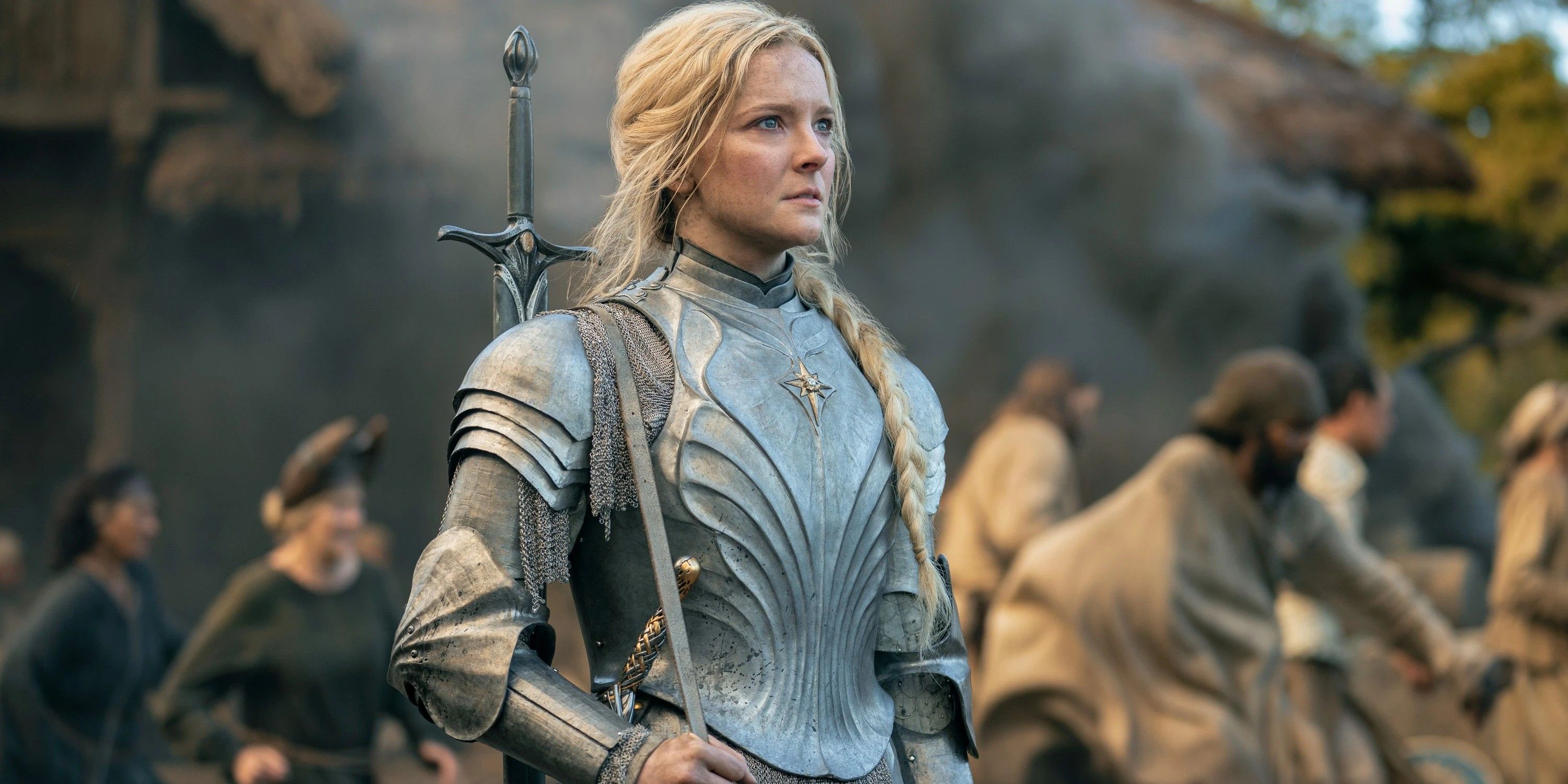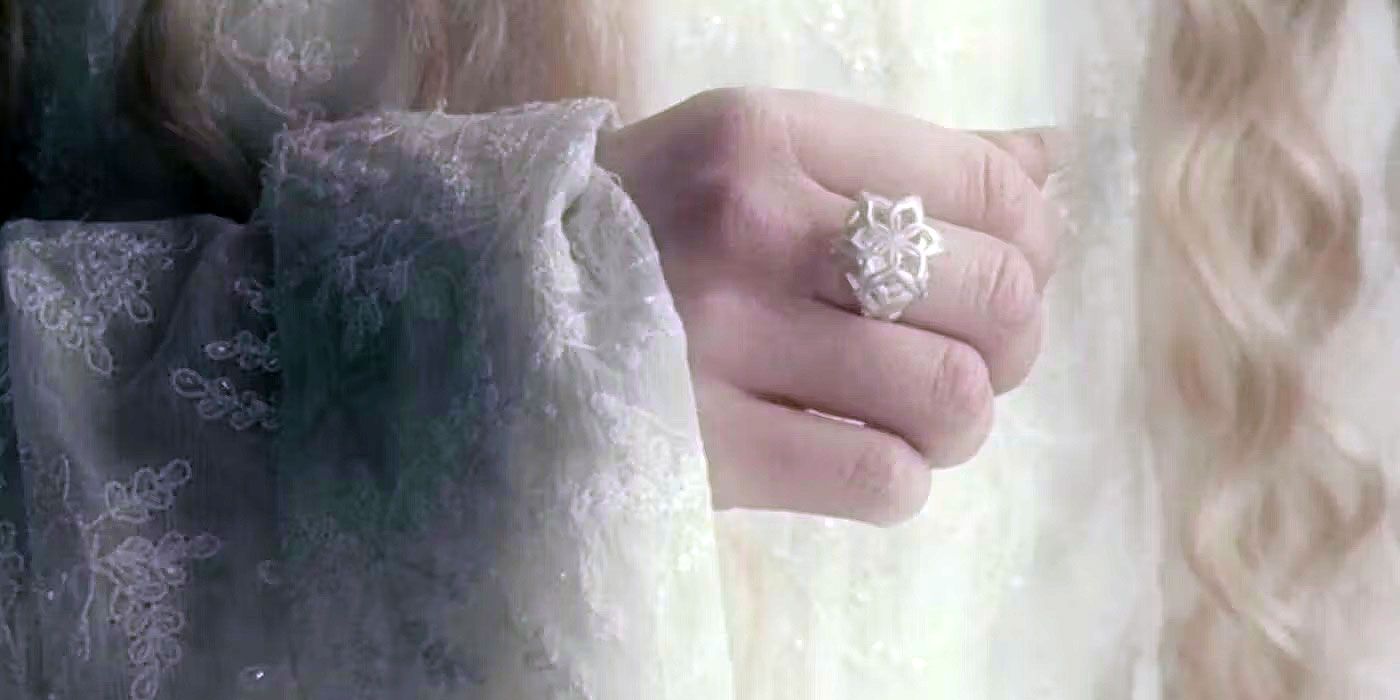
Peter Jackson’s adaptation of The Lord of the Rings is largely faithful to J.R.R. Tolkien’s seminal fantasy work. However, some characters — like Tom Bombadil and the resurrected Elf Glorfindel — didn’t receive their due. Still, while most fans were pleased with the film trilogy, there was one scene in The Fellowship of the Rings where some didn’t care for Jackson’s interpretation: the interaction between Galadriel and Frodo in Lothlorien.
During their meeting, Galadriel considered accepting the One Ring when Frodo offered it to her. Then, suddenly, she was changed into a terrifying “dark form” that could easily conquer Middle-earth with the Ring’s power. Understandably, the sequence may confuse some fans. Yet, Jackson’s dark depiction of Galadriel — as “beautiful and terrible as the dawn!” — makes sense from a certain perspective, despite the moment straying slightly from the novel.
Updated on November 16, 2024, by Christopher Raley: Galadriel is a significant character in the history of the elves because her life reaches back to the awakening of the elves. She lived at Valinor and returned to Middle-earth with the Noldor, surviving both their curse and the repeated wars waged against the elves by Morgoth. More details about Galadriel’s temptation by the One Ring have been added to this article and general updates to conform to CBR’s current publishing standards.
The History of Galadriel Begins Before the First Age
She Remembers Middle-earth as It Was Long Ago








When the Elves first awoke in Middle-earth, they spent many years wandering Middle-earth under the starlight (the sun and moon had not yet been created). Only when the Valar took them to the Undying Lands did they realize just how much they could accomplish. Many great Elves were born in Valinor long before the First Age, and the iconic Galadriel was one of them. As the daughter of Finarfin, she was a high-ranking member of the Noldorin nobility, but she was also known for her grace, beauty, and, perhaps most importantly, her fiery spirit. On three separate occasions, Galadriel’s close relative Fëanor begged her for a single strand of her radiant hair — which she haughtily refused.
After living in the region of Middle-earth known as Beleriand (which fell into the sea because of the War of Wrath), not to mention living over 8,000 years, Galadriel became much kinder and gentler than she was in the past. As such, she gladly offered three strands of her hair to Gimli, despite the bloody history between the Elves and the Dwarves. In the main LOTR storyline, Galadriel remained quite mighty, although she presumably began craving the unpolluted atmosphere of Valinor. By the end, she returned to the Undying Lands whence she came, and would never be seen again in Middle-earth.
Galadriel’s Darkness Was Portrayed Differently In the Book
Her Transformation Seems to Be Something Only Frodo Perceives

In place of the Dark Lord, you would have a Queen, not dark, but beautiful and terrible as the Dawn. Treacherous as the Sea! Stronger than the foundations of the earth…all shall love me and despair! — Galadriel in Peter Jackson’s The Fellowship of the Ring .
Note how Tolkien uses the word “seeming” when describing her change of appearance, which may suggest Galadriel’s dark form is something only Frodo can see. It is as if the Ring had granted him a vision of what could happen if the great Elf were to wield its power. Tolkien ultimately confirms this through the presence of another character in that scene that the movie leaves out: Samwise Gamgee. Sam was with Frodo during this moment, and he too looked in the mirror, but after the exchange between Frodo and Galadriel, Sam reveals that he couldn’t see what took place. This confirms that Galadriel’s transfiguration was something only for Frodo to see.
Jackson, on the other hand, uses Galadriel’s dark form as a visual cue for the audience. Specifically, it represents how she would become evil if she gave in to her deepest desire. In a sense, the audience takes the place of Frodo, viewing this insight into the nature of Galadriel’s temptation. At the same time, Galadriel’s ultimate rejection of the One Ring proves that her spirit was as strong as it was noble. And it’s worth reiterating that the film is ultimately faithful to the book in portraying Tolkien’s intent. Galadriel was tempted by the ring but resisted it.
Galadriel Chose to Stay In Middle-earth After Morgoth’s Defeat
Tolkien Does Not Specify Why

Choose not the path of fear but that of faith.—The Rings of Power, Episode 4
As shown in J. R. R. Tolkien’s The Silmarillion, Galadriel experienced the splendor of the Valar and the light of the Two Trees. However, her life there was cut short after Morgoth stole the Silmarils and killed King Finwë, prompting the nightmarish Oath of Fëanor. When the Noldor consequently rebelled against the Valar, Galadriel was part of the rebellion and was exiled with the rest of her people, although she didn’t partake in the Kinslaying at Alqualondë. However, she was more than happy to go to Middle-earth. As shown in J. R. R. Tolkien’s The Silmarillion, Galadriel experienced the splendor of the Valar and the light of the Two Trees. However, her life there was cut short after Morgoth stole the Silmarils and killed King Finwë, prompting the nightmarish Oath of Fëanor. When the Noldor consequently rebelled against the Valar, Galadriel was part of the rebellion and was exiled with the rest of her people, although she didn’t partake in the Kinslaying at Alqualondë. However, she was more than happy to go to Middle-earth. In Episode 1, Elrond also reveals a prophecy that Galadriel might inadvertently help Sauron rise to power once more if she remains in Middle-earth. In the Season 1 finale, Episode 8, “Alloyed,” Galadriel faces temptation from Sauron to join him. Sauron claims they both wanted to heal Middle-earth, and he believes she can connect him to the light as he would bring her power. In “The Mirror of Galadriel,” Galadriel sees a vision of this future in the water where she and Sauron rule over Middle-earth as queen and king. Galadriel rejects Sauron’s temptation and instead helps forge the three Elven Rings of Power to combat Sauron’s influence.
In Episode 1, Elrond also reveals a prophecy that Galadriel might inadvertently help Sauron rise to power once more if she remains in Middle-earth. In the Season 1 finale, Episode 8, “Alloyed,” Galadriel faces temptation from Sauron to join him. Sauron claims they both wanted to heal Middle-earth, and he believes she can connect him to the light as he would bring her power. In “The Mirror of Galadriel,” Galadriel sees a vision of this future in the water where she and Sauron rule over Middle-earth as queen and king. Galadriel rejects Sauron’s temptation and instead helps forge the three Elven Rings of Power to combat Sauron’s influence.
Galadriel Admits Pondering What She Would Do With the Ring
She Truly Desired to Overthrow Sauron

With her Elvish magic, years of hard-earned wisdom, and Nenya on her finger, Galadriel was easily the most powerful Elf in Middle-earth during Tolkien’s trilogy. The Rings of Power, also shows how much of her life was embroiled in the war against Sauron. Despite her refusal to give into Sauron’s temptation in The Rings of Power, she was still not immune to temptation and wondered what it would be like to find Sauron’s Ring and use it to overthrow him. Her intentions would be pure because she sought to instill peace.

Ultimately, however, Galadriel would have been corrupted by the power of the One Ring, and her beauty would become an object of fearful worship. Thus, Galadriel’s dark form in Jackson’s The Lord of the Rings personifies what would have occurred had the Lady of Lothlórien given in to temptation and taken the One Ring for herself. She would have succumbed to evil because the Ring was indomitable, even with her overwhelming power.
In the grand scheme of things, Galadriel’s temptation scene was fundamentally the same in the book and Jackson’s adaptation. The only difference was who perceived this vision of Galadriel. In Tolkien’s novel, Frodo saw Galadriel’s dark form in his mind, while, in the movie, Galadriel represented her own temptations with a literal transfiguration. Some fans might have preferred to see Galadriel deliver her lines without being a dark figure. Overall, however, it was a helpful, evil visual for the audience to show Galadriel’s reasons for refusing the One Ring and guiding Frodo on his journey.




